Ivy Style today: The Symposium video, New York
Last week's Symposium in New York was hugely enjoyable.
There were over 200 enthusiastic people in the audience (standing room only) and I think the speakers were perfect.
Alan Flusser gave the historical background on Ivy style (having lived it himself, and spent the last 12 years researching it for the official Ralph Lauren biography); Richard Press gave his family's side of the story at J Press, plus very personal enthusiasm for the style; and Sid Mashburn talked about how was inspired and inherited Ivy - and is making it relevant to men in his stores.
Then the more modern influence: designer Todd Snyder discussed about how he uses and evolves Ivy; and Nick Sullivan from Esquire touched on the pure fashion side. I sat in the middle, asking dumb questions.
The photo above is Alan (endearingly) attempting to show a photo to the crowd, illustrating the elegance with which proponents of Ivy style mixed tailoring with sportswear.
And this was the first fundamental thing I learnt about Ivy on the night: that it is about the attitude, not the clothes.
Not the khakis or the oxford button down, not the sack suit or the repp tie, but the easy, nonchalant way a certain class of students put clothes together.
The second thing I learnt was that Ivy style survived so well – became the American style – because it was so adaptable. Because it evolved.
Ivy originated in the 20s, was democratised by vets in the 50s, and became preppy mainstream in the 80s. The French had their version; the Japanese mixed it (feverishly) together.
Which is why purists make perhaps less sense in Ivy than anything else.
I genuinely think Ivy has never been more relevant than it is today.
It was an easy way to wear tailoring, and one that emphasised comfort, sportswear, quality and looking after your clothes. It was elegant but not corporate. Very now.
I won’t write any more, but let the men themselves explain everything. The video is below – I hope you enjoy it.
Many thanks to Thomas Mason for their support and making the event happen. Thank you to the 224 people that attended. And thank you to the speakers:
- Alan Flusser
- Sid Mashburn
- Todd Snyder
- Nick Sullivan
- and Richard Press
Oh, and by the way, Richard Press was – for a year – a member of the Rat Pack.
This was a story I never quite managed to get into the conversation. Let me tell it now.
Frank Sinatra and his entourage turned up one day in J Press. Sinatra wanted to try the soft Ivy look, having mostly worn sharp continental clothing up to that point.
Richard (below) showed him the rack of suits. Sinatra tried on one, liked it – and bought the entire rack. Plus suits for the entourage. This was fortunate because Sinatra could not tolerate trying on multiple things, or fittings: it was either right or it wasn’t.
The next day Richard gets a note, saying Mr Sinatra will be playing at the Copa, and there will be a table at the front for Richard and his wife, if they would like to come along.
Richard is invited to the next show as well, and for a year he is part of the crew accompanying Sinatra, looking after his wardrobe.
After a year, Richard gets another note. It says ‘Mr Sinatra will no longer be requiring your services’. He’d moved onto another style: Ivy was no longer for him. The equivalent of being dumped by text.
A little frippery to end with.
Enjoy the very serious discussion in the video, of genuine elbow patches and big American colour.
In the video, I am wearing a (vague) version of Ivy style:
- Grey herringbone suit from The Anthology (review coming soon) in a very soft shoulder
- Pink button-down shirt in PS Oxford cloth (coming next year)
- Black knitted tie from Tie Your Tie
- Black cordovan tassel loafers from Edward Green
Photography: Elliot Hammer


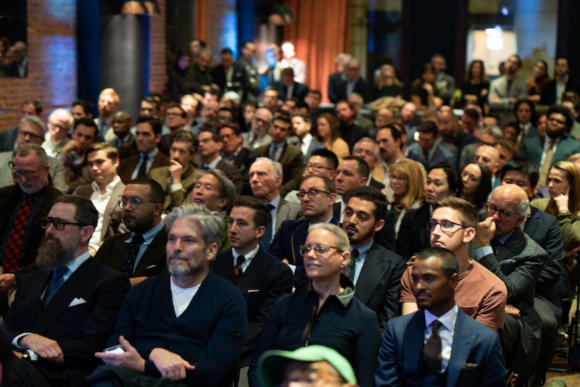
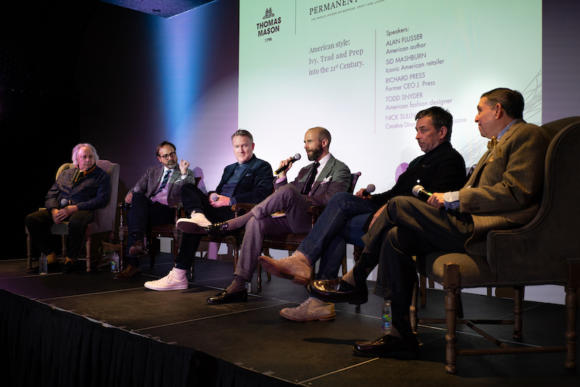
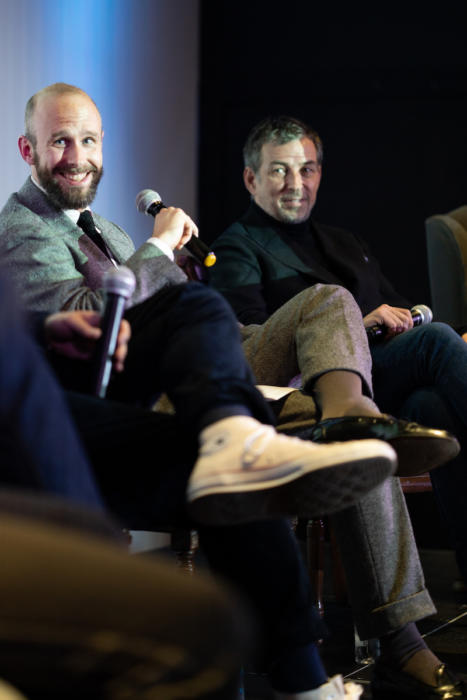
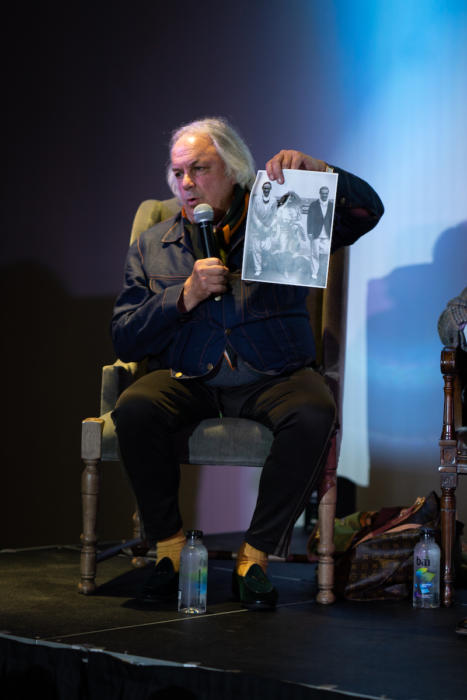
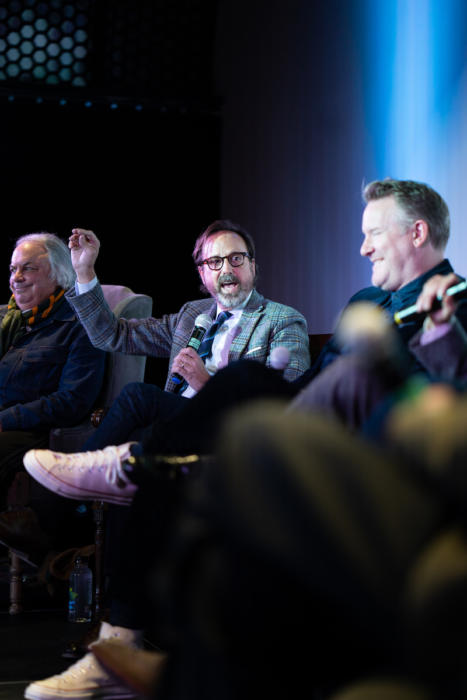

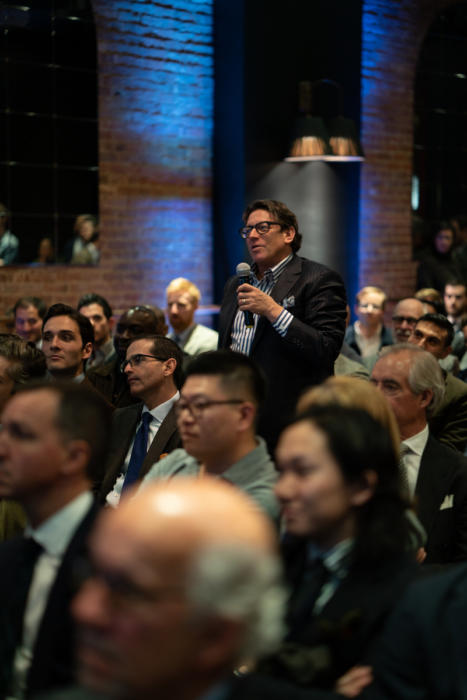
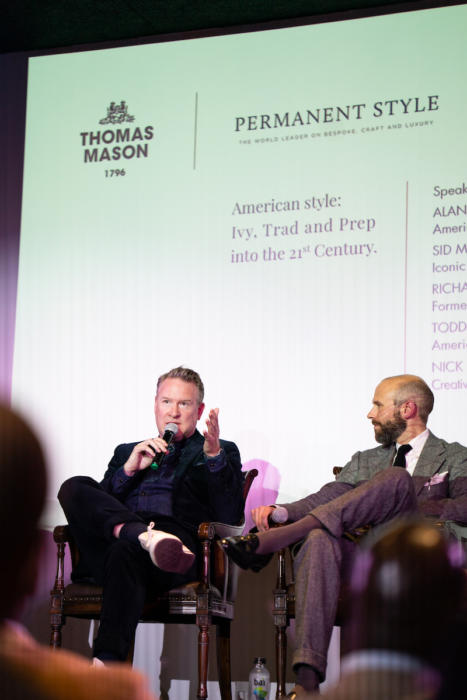

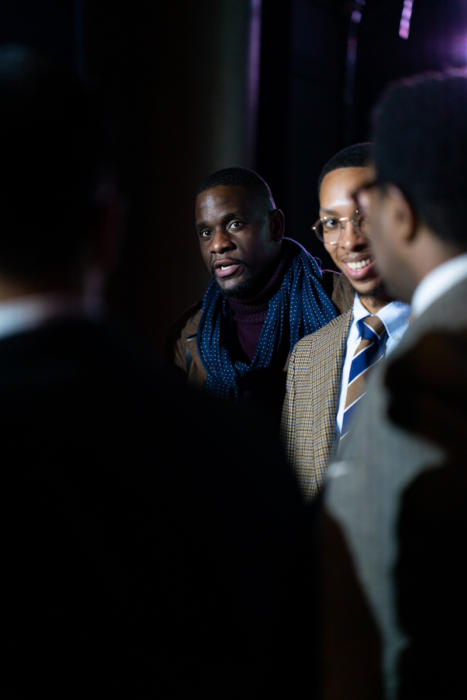
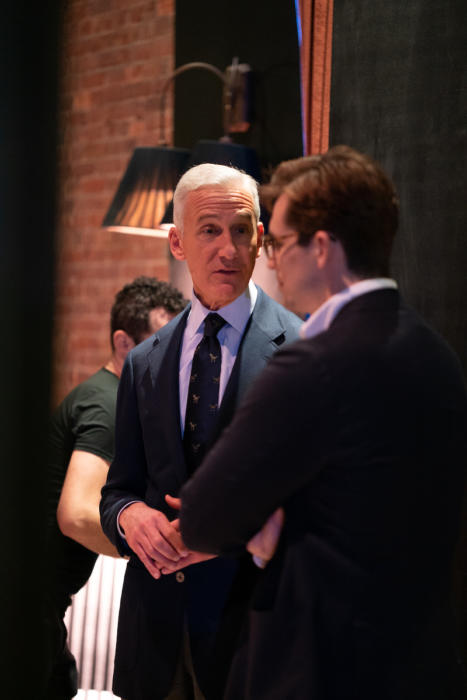


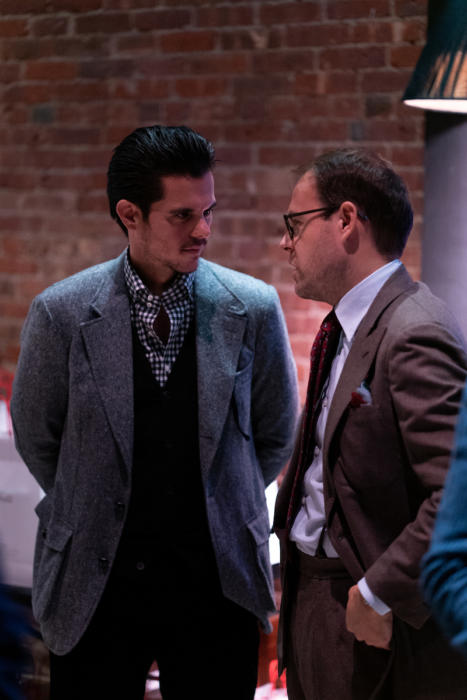
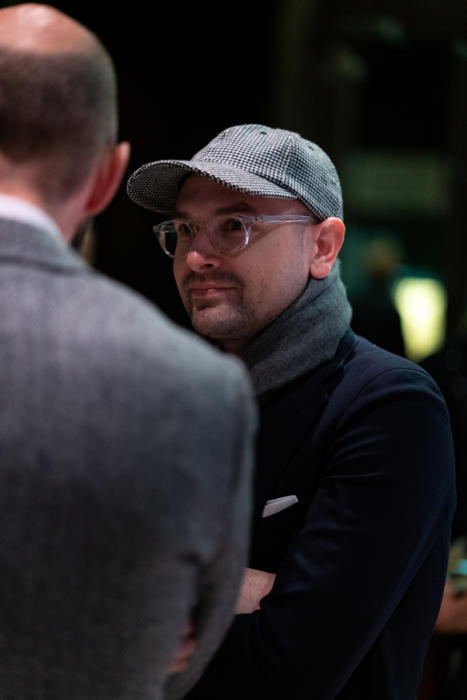
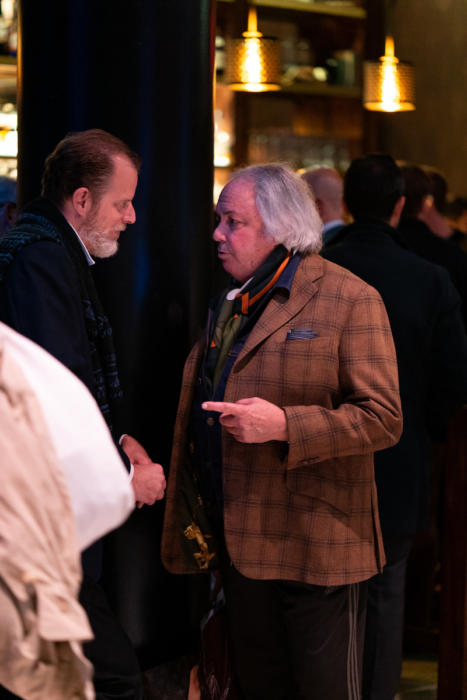
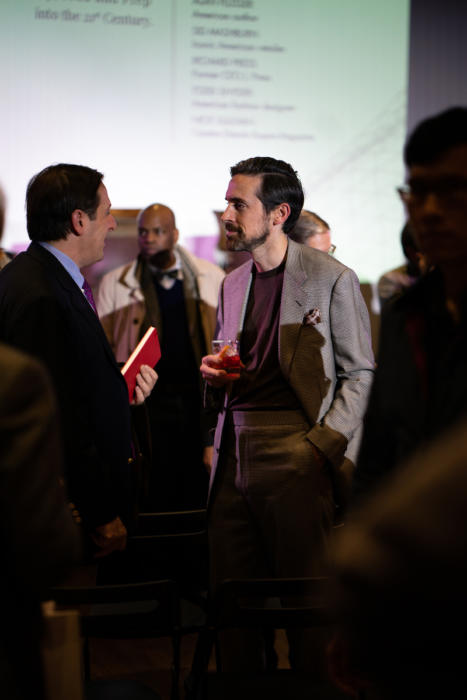

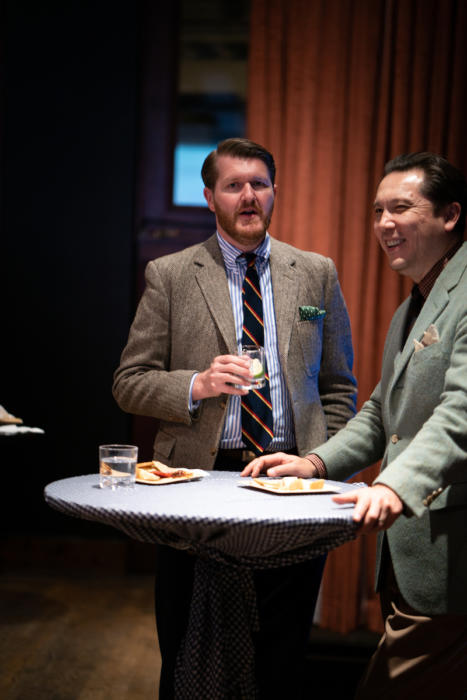


























Regarding mixing sportswear with tailoring, I feel it’s a missed opportunity that Flusser’s Adidas sweatpants didn’t come up during the conversation.
I knew that would draw the first comment…
Hardly surprising. Adidas track suit bottoms with yellow socks and Belgian loafers ? Come on Simon, as polite as you are, even you must have raised an eyebrow when you saw him.
I didn’t, but that’s because he’s worn that for years
Wow! Either he’s thick skinned or someone hasn’t the heart to tell him.
By the way, if you want an explanation from Alan on why he dresses this way today, it can be found here:
https://alanflusser.com/musings-from-alans-desk/alan-flusser-style
Yes, sorry for being predictable! Not meaning to troll his sartorial choices needlessly; it’s also a genuine question I posed myself, of whether today’s sportswear could be elevated in a similar way to OCBDs were a hundred years ago. My tentative answer would be: probably not, but open to be proven wrong.
I agree, almost definitely not.
I think the key is not cut or intended use of the item of clothing but the material. To me wearing moleskin or corduroy with linen, for example, would be odd as the materials are too different in weight, structure etc. The same with modern sportswear – the majority of it is synthetic and it is plain odd seeing shiny synthetics being worn with wool.
On another note, I understand the great benefits of modern sportswear materials, I wear them myself. However, I do think we should be shifting away from artificial materials where we can (ie shouldn’t be worn when not intending to sweat heavily), given their significant negative environmental impact.
I think that’s a good point Nick. Although I wouldn’t wear this personally, I find it much more understandable wearing a great loopback grey pair of sweatpants (eg from Real McCoys) with a shetland sweater and coat thrown over the top. The quality and the natural materials make better sense together.
Hardly surprising to see this being the first comment, as Simon mentioned. It is also what I first noticed. I’ve seen Mr. Flusser wear the same thing before and I’m sorry but it just looks sloppy.
I’ve never read Dressing the man, but I’ve seen a lot of archival pictures of him, and I’ve always been surprised how hyped he’s been. Horizontal striped shirts, including collars, comes to mind as another (to me) questionable sartorial choice.
I’m not one to talk down on his choices, but I’m genuinely interested in why he is choosing adidas bottoms though. A pair of roomy flannels or cords are just as comfortable. And even if he prefers the track suit, I’d argue non branded ones, like PJT offers or a simple drawstring trouser like Informale or A&S would look better.
I think it’s all about context. I can actually see track suit bottoms working on a Sunday, throwing on the favorite coat, tweed jacket or cardigan, for a coffee run or a hung over brunch with friends. But in this context, no.
I’m very much looking forward to checking out the Ralph Lauren book he has been working on though.
I haven’t had time to look through the whole talk yet, but so far it’s a very interesting discussion. And in today’s sartorial climate where most people can wear wherever they want, it makes a lot of sense.
Thanks JB.
Aside from everything else, I do recommend reading Dressing the Man. It’s still the best book out there.
Thanks Simon. Something to put on the Christmas wish list then.
Get over it, the man can wear what he wants. I didn’t notice initially and on closer inspection I don’t find it sloppy. The world would be a terribly boring place if everyone conformed to ‘flannels or cords’ or followed exacting rules about the direction of ones stripes.
A bit surprised to hear Alan Flusser’s suggestion that the “big-boned” American (as he charitably put it) could pull of high-colour items of clothing more effectively than skinny Europeans could. Having been subjected to hordes of tourists rocking brightly-coloured polo tops during the height of summer in a number of Mediterranean destinations, I’d argue that isn’t the case. Although maybe I’m interpreting his point too broadly, and he was very specifically describing the use of such clothing on the golf course?
No I think it was a broader point. It surprised me as well
With regard to being big-boned, just compare Ethan Newton to yourself Simon. You are both bald, bearded men with similar skin-tone and he can pull of some bolder looks that would look a bit off on you (no offense Simon!). I think body size definitely plays a role. Not exactly sure why, though.
Also, with regards to the way Alan Flusser dresses, I think a lot of people miss the point. I would never dress the way he does and I wouldn’t recommend the way he dresses to anyone else either. But, I do admire the way he dresses–I think it is part of his identity. He seems to be fashioning himself as some sort of literary character. It goes with his whole personality. You picture him and you have a distinct picture in mind. It is sort of like Fran Lebowitz. She wears Anderson and Sheppard jackets, Hilditch and Key shirts, tortoiseshell glasses, Levi’s, and cowboy boots. It doesn’t look great, but that is not really the point. It is part of her character. It is her uniform. It demonstrates her larger personality. You picture her and you have a distinct image in mind.
Interesting, nice example on colour.
On the contrary I would argue that Fran Lebowitz looks great precisely for the reasons you have described. Certainly better than the reams of ‘classic menswear’ dross that is all over Instagram. Staged photos of perfectly manicured lapel/ collar/ tie pictures, BLAHH. Vive l’indiosyncratique!
Wearing sweatpants to a panel discussion in New York in front of 200+ people…really? Forgive me Simon, but Mr. Flusser is giving me sartorial indigestion with that ensemble. And Mr. Synder wearing high top Converse tennis shoes is another head scratcher. Quite frankly, it’s hard to take people seriously when they dress like that.
I’m making no attempt to defend it.
I’d only say that it would be nice to talk about the more interesting things in the discussion! Like how does Ivy play out today? Do people agree with me how relevant it is?
Can it be worn with no regard for some of the original rules on combinations – such as not wearing jeans?
Agreed. This discussion had a lot of interesting components. For example, It was interesting to learn that the Ivy style emerged around the same time as HRH the Prince of Wales was beginning to develop his own style, what I call the English country look. I personally note a lot in common with the American Ivy and English country styles today, both of which I like very much. An excellent example of the modern Ivy style is always Ralph Lauren, but personally I’m a big fan of Paul Stewart.
Yes, good point. The upper classes in both countries were very interconnected, and a lot of Ivy drew on English staples too
Simon I enjoyed this very much but can’t help thinking that you are dressed in a very formal way for a discussion about Ivy style.
A suit? Knitted tie? Hardly Ivy.
I noticed this also on your HK symposium.
Thoughts?
Well tweed tailoring, an oxford shirt, a knitted tie and tassel loafers are pretty solid Ivy.
And I also tend to dress a little smarter at an event like this, in the evening, particularly if I’m the host.
VSF, I couldn’t agree with you more.
With the exception of Simon, the panellists hardly constituted a sartorial smorgasbord. Indeed, in some instances they looked like they’d been dressed by carers for a dominoes game in a rest home .
No wonder Bruce Boyer’s photo shows his face contorted with angst. He must be seething at having his microphone taken by these failed flaneurs !
Jason, I was always taught that when making a presentation one should always dress appropriately and well. The purpose was twofold; to be taken seriously and to show respect for the audience. From that prospective, a number of the panel participants failed miserably, with Mr. Flusser and Snyder being the worst offenders. I’m sure Bruce Boyer was horrified, and properly so, with the overall appearance of the panelists. What possessed some of these knowledgeable and sophisticated men to dress so inappropriately is a mystery. They say that with age brings wisdom, but sartorial wisdom was sorely lacking In this case unfortunately. Your nursing home analogy was brilliant and perfect for Mr. Flusser. Todd Snyder looked like an overgrown teenager. As much as I like and respect Sid, his choice of denim was I think inappropriate for the venue.
Would you have the same reaction if he had worn duct taped penny loafers with holes in the bottoms? That would have been the height of sartorial excellence during the 80’s trad phase. I agree with you, its not what I might have worn given the situation, but that is kind of the point. Ivy is about comfort, ease and nonchalance.
Tracksuit bottoms and highly tops. To paraphrase the great G Bruce Boyer. We have lost our sense of occasion.
Alternatively have we lost our sense of occasion?
Simon (and at least you looked nice on the panel), I think Ivy Style is very relevant today. That is to say borrowing and taking inspiration from it is still relevant. What will kill it are the ultra-orthodox adherents who treat the tome “Take Ivy” as if it’s some kind of a rule book. There were never any express rules to dressing Ivy, it’s simply an aesthetic with some fairly obvious attributes. Is a tweed 3 roll 2 jacket over a buttondown and navy Shetland crewneck not Ivy if it’s worn over jeans? Is a Polo coat not ivy if it’s worn over a structured British suit? Of course it’s still Ivy, and these elements will continue on and outlast many of the more Continental influences in my humble opinion.
Good points. As Sid pointed out to me when we were chatting before the talk, our images of the past are also always a little narrow, and things were never implemented quite as closely as we imagine.
“And this was the first fundamental thing I learnt about Ivy on the night: that it is about the attitude, not the clothes. Not the khakis or the oxford button down, not the sack suit or the repp tie, but the easy, nonchalant way a certain class of students put clothes together.”
“I genuinely think Ivy has never been more relevant than it is today.”
Having attended the institution perhaps most closely associated with Ivy style, I’m quite certain that it’s all about the clothes and far less relevant today. The students who still subscribe to the prep do so with the same nonchalance as a Time Square Elmo. It’s most charitably irony, not nonchalance, that describes their attitude. And you’re right to describe these kids as of a certain class: the primary cultural relevance of Ivy today is sustained by its commodified association with a particular regional wealth. There’s a reason all the blabber on the subject reference black and white pictures.
I’m not a style expert, however, I was impressed with the mix of Saville row jacket with jeans, boots, and hat in the movie Under the Volcano. It may not be preppy but it is an interesting juxtaposition.
I’m surprised how badly presented some of these individuals are. It’s almost an insult to the audience.
If they’re trying to be edgy, it failed miserably.
I think it’s interesting to compare the photos of Alan Flusser with the one of Bruce Boyer: both men of a similar age, both considered experts who have literally written the book on style, but only one who still makes an effort (in my humble, trackie bottomed-less opinion).
Wow, the amount of comments on what people were wearing! Gees, get over it. Panel discussion about a topic and ideas, not a catwalk.
well, in this context, what the speakers are wearing is highly relevant…
Why?
Wouldn’t you find it odd if the speakers at a wine masterclass were drinking coke?
Even though I’ve commented on Mr. Flussers track suit pants too, I agree. The panels expertise and comments are no less relevant because they’re wearing converse or denim.
I’m curious as to why everyone seems to expect the panel to be dressed to their teeth? If you’re any bit familiar with them it’s easy to see they’re very much wearing some version of their own every day uniforms.
As for Ivy today, I’d say the idea behind it, wearing staples you take care of and mixing sportswear with tailoring etc is very much relevant today, while the cultural connotations associated with the term “Ivy style” isn’t.
i dont think that one topic is overriding the other. you can have two perfectly good separate discussions.
i dont mind if they always dress like this. the fact that it is “their style” doesnt mean that they are “stylish” or appropriate for the occasion. i like simon mashburn and press outfits because, while following their book, they incorporated some ivy elements and still dressed adequately. the other three are just noise in the panel. in particular, regarding flusser, for a man that wrote the book on rules for dressing the man such behaviour does not make sense. it is like nobody dares to tell him he is naked.
i also think that “developing my style” has gone too far in the menswear world. breaking the rules and trying new things can easily fall into hybris. experimentation is cool as long as you dont lose focus, but there is no need to justify on “self expression” every weird thing that goes through your mind in terms of combining garments. at some point is better to stop “being cool”.
An every day uniform may or may not be appropriate for a presentation or panel discussion, particularly if the audience, as was the case here, is knowledgeable and astute. Mr. Flusser looked clownish, Todd Snyder looked childish, and Sid Mashburn looked like a frat boy. The adult dresses appropriately for the event which is a sign of respect and good judgment. The subject of this meeting was Ivy League dress. I don’t think it’s unreasonable to suggest that the participants at least dress in a manner, even if vaguely, that resembles the Ivy League style.
As has been correctly pointed out many times on this site, what one wears definitely has an impact on how a person is perceived, like it or not. As knowledgeable as Alan Flusser is, his message was compromised to some extent by his refusal to put on a decent pair of pants and a nice shirt to go with his beautiful jacket.
Cher JB,
I don’t think anybody is suggesting that the panellists should be “dressed to the teeth” but when you are attending an event hosted by ‘Permanent Style’ you might be expected to adhere to what is on the can !
The reality is that supposed industry experts often flounder because style is something you either innately have or haven’t. That’s what makes it so interesting. It’s not something you can hire for the night.
Imagine a panel comprising Cary Grant, David Niven, Bryan Ferry, Steve McQueen and George Best. They would all look completely different but there would be style in abundance.
Of course, these gentleman were selected to discuss ‘Ivy League’ and its relevance. For me it’s always been just a way for Americans to sell their perception of old England to Americans. Ralph Lauren has made a mint doing it when he’s not dressed like a cowboy.
Salutations,
Jason
Interesting video. I think Mr. Flusser would be amused by this discussion. After all, the go-to-hell look is a classic Ivy style. I have flirted with Ivy over the years after initial introduction in the 80’s via John Simons shop and Dexys Midnight Runners almighty classic LP “Don’t stand me down”. I remember at the time they were criticised for looking like used car salesmen! In the end, I preferred the British take on things- more tailored, more formal but still incorporate Ivy elements of Ivy on occasion: button-down shirts; cordovan shoes; conspicuous layering etc. etc.
Wow! Pink OCBD and the striped RTW shirts haven’t even dropped yet! I can’t wait!
The video is an awesome chat though Simon and very insightful. I’m almost to the end.
As an addition to the post , I’d suggest going to the John Simons website, looking at the blog ( BTW not recently updated), to look at some of the posts including one from the London Guardian- The man who dressed the mods.
This is I would suggest, a good example of how the Ivy style can be and was adapted, in this case to the British Mod culture. Plus he looks great too!
I am also going to take credit for “Detroit” being on the tip of your tongue, given our discussion at the Armoury right before the event.
You should do.
And I’m sorry Detroit…
Some great and amusing (Jason) comments. Really, there are two issues; the meaning and relevance of Ivy (aka prep) style and those speaking about it. Taking Ivy out of the museum of the past it was, undoubtedly, an expression of a time and place by a particular class of American individuals. A young, elite, moneyed class that rejected the formal: old suit silhouettes, trad shoes (for Bass Weejuns – a type of moccasin loafer popular with the ‘Beat’ generation) and the colourful, almost gaudy, wide ties of the 40’s for rep style. Essentially it was a youthful, intelligent response (not quite a rebellion) to the spare style inheritance of the 1940’s. Ivy harked back to the ‘old English’ sporting codes and Windsorial influences (his 1955 visit to USA) that played with formal style. This response was repeated, more forcefully, by the next generation that swung to the colourful expression of flared jeans and flower power of the 60’s and 70’s.
Separately, the speakers brought their own take on the theme. If Ivy was a response to the traditionalism of the former generation then the mix of Ivy and leisure-wear is, logically, though controversially, an extension of the ethos set by Ivy. I recommend ‘The Sartorialist’ for more on the subject wherein the well dressed avant-garde of Paris, Milan, London and NY are ‘mixing the streams’ as a response to the corporate drone dress codes as expressed by many of the main, American, fashion, retailers (Gant, Polo, BR, Hilfiger etc.) that, ironically, include trad. Ivy as a mainstream style. In essence street and athleisure style is the latter day inheritor of the Ivy ethos – the narrowly interpreted, formalised, repetition of ‘Ivy’ is not. Maybe Flusser, in his own quietly ironic way, was expressing this.
Notwithstanding the many comments here on the panelist’s own styles, which I agree had some impact, I was very impressed by the panel individually and a whole for their perspectives on ivy style during the 2 hr discussion. They brought historical (Flusser, Press), southern (Mashburn), japanese (Snyder), european (Sullivan, Flusser) and current marketing (Mashburn, Snyder, Sullivan) views and experiences all at one interesting time. I was glad to see Richard Press added to the panel names earlier announced since he has a unique and personal experience in ivy. I had the least knowledge of Nick Sullivan and Todd Snyder. Sullivan however impressed me with his knowledge, history and perspective both as a creative director and being english. Snyder’s knowledge of Japan lead the discussion on that. All were funny and their interactions, comfort and respect for one another was obvious. The interaction with the audience was also easy with folks finishing their sentences for them or filling in a name they couldn’t remember easily (something I understand). I do think that it was unfair for Richard Press to have his grandaughter as a shill but I loved her comment from both that perspective and as a woman. I think it’s unlikely that we’ll see often, if at all, in the future, a group with as much knowledge and types of perspective that those of us with an interest can listen to and learn from. Also Simon I thought your role as moderator was just right, keeping the discussion going and ensuring that each person was heard. I enjoyed it all and likely will revisit it at some point. Last night was a good night since after watching the panel I finished reading James Sherwood’s new book on Henry Poole.
Randy Ventgen
Vancouver Washington
I’m so pleased all our work in putting it together created something you appreciated, Randy.
James’s book is superb, as is pretty much everything else he’s ever written
Simon
Enjoying this post I quickly noticed that one of the men in the photo Alan Flusser is “showing” is the father of a good friend of mine. The gentleman in the tennis sweater and DB jacket is Anthony J “Tony” Drexel Biddle, Jr. His son Tony III and I served in the Navy together.
Tony in the photo was frequently included in the Best Dressed lists in the years between the two World Wars. He was usually described as a “socialite and sportsman”. He was recruited into the Foreign Service and was the US Ambassador to Poland when the invasion occurred. He and his family were evacuated to London, where he became Ambassador to the “Governments in Exile” and an active duty General Officer.
Tony traveled with numerous Louis Vuitton trunks made especially for his wardrobe.
Back in the 70’s my friend Tony III gave me one of his father’s sets of White Tie. They were made in 1939 by E. Tautz & Co., Savile Row. They are inscribed in an inside pocket: for His Ex., the Hon A.J.D. Biddle, Jr.
I still have them.
Thanks for everything you do,
Jack Enoch
Richmond, VA
(Where we have been Ivy, or at least Prep, forever…)
Amazing Jack. What an inheritance.
Brilliant conversation….great give and take. Thanks for putting it together and recording it so we could all listen in.
Hi I haven’t read Alan Flusser’s book though I’m now intrigued. I just love that he does his own thing. Brilliant. Keep writing and surprising us Simon. It’s what life”s about.
I wanted to add some comments about sources the panelists recommended regarding ivy style. I agree with Richard Press on the effect of Bruce Boyer’s book True Style section on ivy; in it Boyer also references Christian Chensvold (as I believe Alan Flusser did after the Symposium) for his seminal 43 pg essay in 2013 “The Rise and Fall of the Ivy League Look” on his blog Ivy Style (along with pages of comments)-also the FIT exhibit related book in 2012 Ivy Style. Several panelists mentioned Flusser’s books on men’s style including Dressing the Man-his upcoming release on Ralph Lauren should be interesting. Although not specifically mentioned in the panel’s japanese discussion there is the authoritative David Marx’s book Ametora on american traditional style in Japan, which has more index references to ivy style than any other subject.
Randy Ventgen
Vancouver Washington
Thanks Randy, very helpful. I second Christian’s piece too. We will be doing something with him shortly too hopefully
Absolutely throughly enjoyed this.
Truth be told I think the killer look is that Ivy League look (the non-formal one, i.e., not blazer and tie) with just the right amount of seeming indifference (loucheness perhaps) to what you’ve just put on.
But it is so easy to end up just looking smart-informal and therefore quite ordinary. A seriously difficult look to get just right and newly bought clothes just don’t work because of their, uhm, newness. I remember reading a quote by Ralph Lauren where he said he just loved worn out clothes, and wonderful to hear the stories here about razor blades to shirt collars.
Simon, I was wondering if you knew good places in the UK for classic checked shirts, pleated chinos, herringbone jackets, all the bits and pieces that contribute to the Ivy look (Ralph is obviously not a bad place, Gitman is extortionate, Sid Mashburn has great checked shirts on his website but is in the US)…?
John Simons is a good starting point